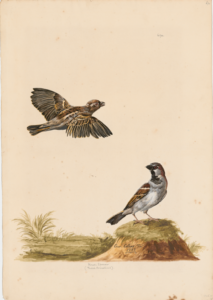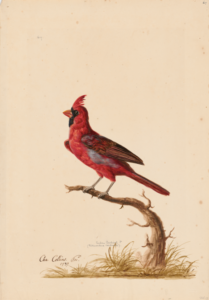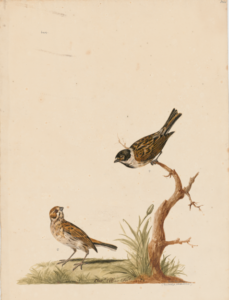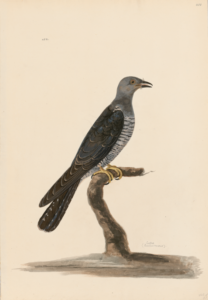By Daniel Lavigne, Senior Documentation Technician
A Silent Spring?
Living in Montreal during the ongoing coronavirus pandemic has given the words “silent spring” a new twist.[1] The streets are eerily quiet. All forms of traffic are significantly reduced. The lines outside of pharmacies and grocery stores are much quieter than those previously outside of music venues and clubs. Yet if you listen closely you may find that things aren’t as quiet as they seem.

Charles Collins. House-Sparrow. Watercolour painting, 1737. Taylor White Collection, Rare Books and Special Collections. CA RBD MSG BW002-670
The first light of day is like an on switch that triggers our well dispersed House Sparrow population. They shout at each other across the street in a manner oddly reminiscent of workers at a construction site. The sheer volume, however, can’t be explained by occupational hearing loss. Whole flocks cram into hedges packed like a rush hour bus to add their voice to what sounds like a massive rant. Higher off the ground, an American Robin begins a singing marathon and a Northern Cardinal, unwittingly complementing an evergreen, yodels its heart out. Somewhere in the distance a Downy Woodpecker lets loose a descending whinny. This is the dawn chorus and no two sessions are alike.
I have been birding (birdwatching) for several years now and have always found it therapeutic. With so many of our hobbies and passions depending on access to shared facilities, lately I have been extremely grateful for this hobby of mine. One windfall of the silence of the streets (and skies!) has been an increase in urban wildlife sightings at a global level. To give but one example, last month the McGill Chemistry Twitter account reported a wild turkey on campus. I won’t draw any strong conclusions here, but I feel the decrease in human activity is working two ways: clearly, nature is being scared off less, but the silence is also allowing us to perceive more.
Birding Basics

Charles Collins. Eastern Cardinal [male] / Northern Cardinal. Watercolour painting, 1739. Taylor White Collection, Rare Books and Special Collections. CA RBD MSG BW002-617
The single most important aid in birding is a pair of quality binoculars. Alternatively, a camera with a long-focus lens can make a good substitute. In any case, don’t be deterred if you have nothing but your raw senses. Besides, birding doesn’t have to be your focus. Bring a book or a craft and tune in to the nature around you. A few hours of exposure can leave a tangle of bird song in your head for the rest of the day.
Spring is hands down the best season for birding. With numerous species migrating and breeding, many birds are in their brightest plumage and easily seen when in deciduous trees that have not yet sprouted leaves. To help you identify birds and know what you can expect to find in a given area or habitat, download an app (I use Merlin Bird ID) or check eBird, a website run by the Cornell Lab of Ornithology.
Remember to keep your distance when the curiosity isn’t mutual: many birds are sensitive and appreciate their space. Furthermore, be mindful of your local COVID-19 recommendations. No need to go far. Since the lockdown I have observed 25 species within a few blocks of my Rosemont apartment, which isn’t located near any major hotspots. Chances are there are more birds in your area than you think. You can also bird virtually via online feeder cams, such as the real-time cams hosted by the Cornell Lab, or test your patience birding on Google Street View.
A Brief Survey of Bird Song in Classical Music

Peter Paillou. White-throated Sparrows [male & female]. Watercolour painting, approx. 1720-1790. Taylor White Collection, Rare Books and Special Collections. CA RBD MSG BW002-643
My passion for birds is closely tied to my love for music. Frequently when listening to music I will be reminded of a particular bird song, a connection that’s difficult to unmake. In some cases I can be positive that the artist never heard the bird in question. It’s unlikely that Mozart ever heard a White-throated Sparrow, a bird found only in North America. Yet in The Magic Flute I can hear its song in the Queen of the Night aria.
Birds have been a wellspring of inspiration for all forms of art and the classical music tradition contains some notable examples. The birds can be mythological or fictitious, as in Stravinsky’s L’Oiseau de feu. Other works take a generic approach to evoking bird song, aiming for a convincing effect, e.g. the Spring concerto of Vivaldi’s Four Seasons. Personally, I am more intrigued by compositions that quote bird song with varying degrees of realism and stylization. The Nightingale and Common Cuckoo are two birds quoted extensively by composers and appear together along with the Quail in Beethoven’s Symphony No. 6 (Pastoral), second movement.

Peter Paillou. Cuckoo. Watercolour painting, approx. 1720-1790. Taylor White Collection, Rare Books and Special Collections. CA RBD MSG BW002-458
Without question the composer most strongly associated with birds is Olivier Messiaen (1908-1992). Messiaen prepared transcriptions of bird song directly from nature and from recordings and worked them into numerous of his compositions. Readers who struggle with mornings may appreciate Messiaen’s interpretation of a dawn chorus, Réveil des oiseaux, a work for piano and orchestra made up exclusively of 38 bird songs.
The advent of sound recording technology introduced pre-recorded bird song into performances. The earliest instance of combining live music with pre-recorded sounds is Ottorino Respighi’s Pini di Roma (1924) in the I pini del Gianicolo movement, which included a gramophone recording of a nightingale. In 1972, Einojuhani Rautavaara went further in Cantus Arcticus (Concerto for Birds & Orchestra), which features field recordings made by the composer.

Charles Collins. Nightingale. Watercolour painting, 1737. Taylor White Collection, Rare Books and Special Collections. CA RBD MSG BW002-685
While it’s unlikely that we will ever see birds perform directly from scores, apparently you can start them off as instrumentalists. In 2015, 70 Zebra Finches played electric guitars at an exhibition at the Montreal Museum of Fine Arts. The installation by artist Céleste Boursier-Mougenot riffs on the universally familiar image of a bird on a wire.
Final Remarks
The intersection of birds and music in my life has provided me with much insight and amusement. During this challenging period, my early morning birding trips before telework have given my days some excitement as well as structure. As the spring migration progresses, the staggered arrival of different bird species is an alternative way of marking the passage of time. It may be some time before concert halls re-open and dinner parties resume, but my hopes of seeing an Indigo Bunting or an American Redstart again are tiding me off. Although our lives may be lacking their usual diversity of activities, focusing on what remains is not without its benefits.
For the complete birdsong playlist: https://mcgill.ca/x/45J
[1] Silent Spring (1962) by Rachel Carson is an influential environmental sciences book that warns of the danger of pesticides and their impact on nature.

